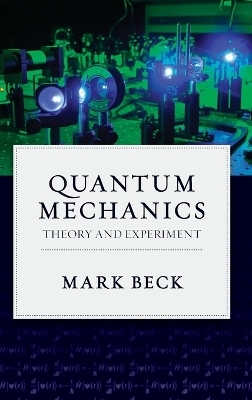
Quantum Mechanics
Oxford University Press Inc (Verlag)
978-0-19-979812-4 (ISBN)
This textbook presents quantum mechanics at the junior/senior undergraduate level. It is unique in that it describes not only quantum theory, but also presents five laboratories that explore truly modern aspects of quantum mechanics. These laboratories include "proving" that light contains photons, single-photon interference, and tests of local realism.
The text begins by presenting the classical theory of polarization, moving on to describe the quantum theory of polarization. Analogies between the two theories minimize conceptual difficulties that students typically have when first presented with quantum mechanics. Furthermore, because the laboratories involve studying photons, using photon polarization as a prototypical quantum system allows the laboratory work to be closely integrated with the coursework.
Polarization represents a two-dimensional quantum system, so the introduction to quantum mechanics uses two-dimensional state vectors and operators. This allows students to become comfortable with the mathematics of a relatively simple system, before moving on to more complicated systems. After describing polarization, the text goes on to describe spin systems, time evolution, continuous variable systems (particle in a box, harmonic oscillator, hydrogen atom, etc.), and perturbation theory.
The book also includes chapters which describe material that is frequently absent from undergraduate texts: quantum measurement, entanglement, quantum field theory and quantum information. This material is connected not only to the laboratories described in the text, but also to other recent experiments. Other subjects covered that do not often make their way into undergraduate texts are coherence, complementarity, mixed states, the density operator and coherent states.
Supplementary material includes further details about implementing the laboratories, including parts lists and software for running the experiments. Computer simulations of some of the experiments are available as well. A solutions manual for end-of-chapter problems is available to instructors.
Mark Beck received his Bachelor's and Doctoral degrees in Optics from the University of Rochester. He has taught physics at Reed College, and is currently the Benjamin H. Brown Professor of Physics at Whitman College. His research interests include quantum optics and quantum measurement.
Preface ; Table of Symbols ; 1 Mathematical Preliminaries ; 2 Classical Description of Polarization ; 3 Quantum States ; 4 Operators ; 5 Measurement ; 6 Spin-1/2 ; 7 Angular Momentum and Rotation ; 8 Two-Particle Systems and Entanglement ; 9 Time Evolution and the Schrodinger Equation ; 10 Position and Momentum ; 11 Wave Mechanics and the Schrodinger Equation ; 12 The Harmonic Oscillator ; 13 Wave Mechanics in Three Dimensions ; 14 Time-Independent Perturbation Theory ; 15 Time-Dependent Perturbation Theory ; 16 Quantum Fields ; 17 Quantum Information ; Laboratories ; Getting Started ; Before Lab ; Important Laboratory Safety Tips ; Lab 1: Spontaneous Parametric Downconversion ; Lab 2: 'Proof' of the Existence of Photons ; Lab 3: Single Photon Interference ; Lab 4: Quantum State Measurement ; Lab 5: Testing Local Realism
| Verlagsort | New York |
|---|---|
| Sprache | englisch |
| Maße | 160 x 236 mm |
| Gewicht | 839 g |
| Themenwelt | Mathematik / Informatik ► Mathematik ► Angewandte Mathematik |
| Naturwissenschaften ► Chemie ► Physikalische Chemie | |
| Naturwissenschaften ► Physik / Astronomie ► Quantenphysik | |
| ISBN-10 | 0-19-979812-5 / 0199798125 |
| ISBN-13 | 978-0-19-979812-4 / 9780199798124 |
| Zustand | Neuware |
| Haben Sie eine Frage zum Produkt? |
aus dem Bereich


